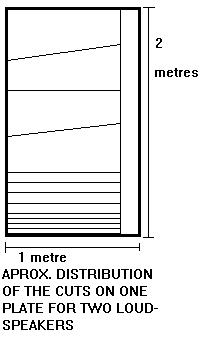The magnets do not float in mid-air, they are held by their own magnetic force
to an iron plate, as the loudspeaker works as a dipole, emitting sound pressure
in both directions, the plate has to be perforated, thus permitting the sound
production and avoiding destructive interference.
The plate is cut into pieces, one big piece for the bass baffle, in my case 93
cm. in height, 29 cm in the top part and 34 cm. in the widest part, see
diagramme. You also need a piece for the back and sides of the tweeter hole,
thus a long 93 x 5.5 cm piece, with long pieces to cover the sides of the
tweeter, also permitting the adherence of the tweeter magnets, 2 pieces of 93
by the width of the MDF plate you buy per loudspeaker.
 First of all, you can choose plates that range from paper thin to very thick. I
chose 3mm. width, this was as wide as possible mostly with respect to my pocket
($$...) and wider than the original project (1.25 mm), 50% air (amount of
perforations). A thicker plate makes the construction more robust, less
propense to vibrations, makes the loudspeaker all the more sturdy and would
theoretically help to acheive a better overall sound. The wider the plate, the
tougher it is to find a place they can cut it. I had a terrible hassle finding
a pneumatic guillotine that could cut the plate, on top of it all, the plate
weighs a lot, a car is a must, or taxis if they are affordable in your country.
They normally sell the plates as one piece, 2 x 1 meter, at least in metric
countries, you can make four back pieces and the rest of the magnet supports
with one plate, so get together and buy the plates as a pair.
First of all, you can choose plates that range from paper thin to very thick. I
chose 3mm. width, this was as wide as possible mostly with respect to my pocket
($$...) and wider than the original project (1.25 mm), 50% air (amount of
perforations). A thicker plate makes the construction more robust, less
propense to vibrations, makes the loudspeaker all the more sturdy and would
theoretically help to acheive a better overall sound. The wider the plate, the
tougher it is to find a place they can cut it. I had a terrible hassle finding
a pneumatic guillotine that could cut the plate, on top of it all, the plate
weighs a lot, a car is a must, or taxis if they are affordable in your country.
They normally sell the plates as one piece, 2 x 1 meter, at least in metric
countries, you can make four back pieces and the rest of the magnet supports
with one plate, so get together and buy the plates as a pair.
I would recommend from my own experience, to give the plate an antioxidant
treatment, paint or varnish, so your loudspeaker has a nicer appearance and
lasts longer. It is also good to get the edges polished after they are cut by
the guillotine, they can be very sharp and dangerous to work with, if they are
not dulled a bit.
Material list
Construction recipe
 First of all, you can choose plates that range from paper thin to very thick. I
chose 3mm. width, this was as wide as possible mostly with respect to my pocket
($$...) and wider than the original project (1.25 mm), 50% air (amount of
perforations). A thicker plate makes the construction more robust, less
propense to vibrations, makes the loudspeaker all the more sturdy and would
theoretically help to acheive a better overall sound. The wider the plate, the
tougher it is to find a place they can cut it. I had a terrible hassle finding
a pneumatic guillotine that could cut the plate, on top of it all, the plate
weighs a lot, a car is a must, or taxis if they are affordable in your country.
They normally sell the plates as one piece, 2 x 1 meter, at least in metric
countries, you can make four back pieces and the rest of the magnet supports
with one plate, so get together and buy the plates as a pair.
First of all, you can choose plates that range from paper thin to very thick. I
chose 3mm. width, this was as wide as possible mostly with respect to my pocket
($$...) and wider than the original project (1.25 mm), 50% air (amount of
perforations). A thicker plate makes the construction more robust, less
propense to vibrations, makes the loudspeaker all the more sturdy and would
theoretically help to acheive a better overall sound. The wider the plate, the
tougher it is to find a place they can cut it. I had a terrible hassle finding
a pneumatic guillotine that could cut the plate, on top of it all, the plate
weighs a lot, a car is a must, or taxis if they are affordable in your country.
They normally sell the plates as one piece, 2 x 1 meter, at least in metric
countries, you can make four back pieces and the rest of the magnet supports
with one plate, so get together and buy the plates as a pair.